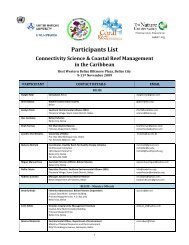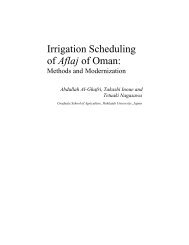The Global Water Crisis: Addressing an Urgent Security - Unu-inweh ...
The Global Water Crisis: Addressing an Urgent Security - Unu-inweh ...
The Global Water Crisis: Addressing an Urgent Security - Unu-inweh ...
Create successful ePaper yourself
Turn your PDF publications into a flip-book with our unique Google optimized e-Paper software.
60,000 ventilation improved pit latrines require less water for flushing (IBM, 2009). Yellow waste could one day be used<br />
for fertilizing urb<strong>an</strong> crops; black waste, for urb<strong>an</strong> agroforestry (IBM, 2009).<br />
3.2. Innovative businesses <strong>an</strong>d partnerships<br />
Governments have a key role in stimulating the Blue Economy by fostering innovation, supporting commercialization of<br />
new solutions, reversing perverse subsidies <strong>an</strong>d establishing the right price signals. But to seize these opportunities, the<br />
world is also going to require pioneers that are ahead of governments <strong>an</strong>d c<strong>an</strong> show the way forward.<br />
One pioneer that is establishing itself in this space is IBM. IBM has launched the <strong>Global</strong> Innovation Outlook (GIO) to<br />
convene diverse actors <strong>an</strong>d explore a variety of pressing topics, including the future of the world’s water resources. <strong>The</strong><br />
comp<strong>an</strong>y is active in promoting adv<strong>an</strong>ced information gathering <strong>an</strong>d <strong>an</strong>alysis as a key part of environmental decisionmaking.<br />
And in 2011, it pledged CAD $20 million of technology investment in the Southern Ontario <strong>Water</strong> Consortium in<br />
C<strong>an</strong>ada to partner with eight universities <strong>an</strong>d over 70 comp<strong>an</strong>ies to create a new platform for innovation in watershed,<br />
wastewater <strong>an</strong>d drinking water m<strong>an</strong>agement.<br />
Examples of pioneering comp<strong>an</strong>ies c<strong>an</strong> be found throughout the world:<br />
• APTwater: A US comp<strong>an</strong>y that has developed a revolutionary technology that c<strong>an</strong> remove nitrates <strong>an</strong>d other<br />
oxidized contamin<strong>an</strong>ts from agriculturally-impacted source water without producing waste.<br />
• TaKaDu: An Israeli comp<strong>an</strong>y providing software for water utilities to monitor their networks, detect leaks <strong>an</strong>d<br />
address inefficiencies in delivery.<br />
• AquaZ: a D<strong>an</strong>ish comp<strong>an</strong>y making sea water desalination economically viable through the use of biotechnology<br />
<strong>an</strong>d n<strong>an</strong>otechnology.<br />
• <strong>Water</strong> Health: a decentralized water utility that is delivering access to cle<strong>an</strong> drinking water in underserved<br />
communities in India, B<strong>an</strong>gladesh, Gh<strong>an</strong>a <strong>an</strong>d the Philippines for less th<strong>an</strong> US $10 per person.<br />
• Ostara: a C<strong>an</strong>adi<strong>an</strong> comp<strong>an</strong>y that recovers nutrients (nitrogen <strong>an</strong>d phosphorus) from municipal <strong>an</strong>d industrial<br />
wastewaters <strong>an</strong>d tr<strong>an</strong>sforms them into fertilizer.<br />
Business clusters are also beginning to work together to collect, share <strong>an</strong>d st<strong>an</strong>dardize data on water conservation <strong>an</strong>d<br />
protection (IBM, 2009). For example, a group of 12 international corporations, including Nestlé <strong>Water</strong>s <strong>an</strong>d <strong>The</strong> Coca<br />
Cola Comp<strong>an</strong>y, has formed <strong>The</strong> Beverage Industry Environmental Roundtable to share best practises concerning water<br />
resource m<strong>an</strong>agement. Other businesses have forged partnerships with environmental org<strong>an</strong>izations. SABMiller plc,<br />
one of the world’s largest brewing comp<strong>an</strong>ies, has partnered with WWF-UK to address the issues of water scarcity <strong>an</strong>d<br />
pollution faced by SABMiller’s local businesses <strong>an</strong>d surrounding communities. <strong>The</strong> partnership has yielded ground-breaking<br />
‘water footprints’, indicators of water use that consider both the direct <strong>an</strong>d indirect water use of a consumer or producer,<br />
<strong>an</strong>d enable the assessment <strong>an</strong>d reduction of water risk (WWF-UK & SABMiller plc, 2009). Another creative partnership,<br />
Aqueduct, was formed by several private comp<strong>an</strong>ies, the Dutch Government <strong>an</strong>d <strong>The</strong> World Resources Institute, a global<br />
environmental think t<strong>an</strong>k. <strong>The</strong> Aqueduct partnership is a tool that measures <strong>an</strong>d maps water-related risks, <strong>an</strong>d c<strong>an</strong> be<br />
used by comp<strong>an</strong>ies, investors, <strong>an</strong>d others to track water risks at a scale appropriate for developing sound business <strong>an</strong>d<br />
investment strategies.<br />
3.3. Non-governmental collaborations<br />
A number of non-governmental org<strong>an</strong>izations are also taking a strong interest in water risk <strong>an</strong>d opportunity. <strong>The</strong> Carbon<br />
Disclosure Project is now producing <strong>an</strong> <strong>an</strong>nual <strong>Water</strong> Disclosure <strong>Global</strong> Report, designed to provide data that informs<br />
decision-making, to increase investor <strong>an</strong>d business awareness of the fin<strong>an</strong>cial risks <strong>an</strong>d opportunities around water, <strong>an</strong>d<br />
to report on global st<strong>an</strong>dards <strong>an</strong>d corporate practices related to water (Carbon Disclosure Project, 2011). <strong>The</strong> 2030 <strong>Water</strong><br />
Resources Group was formed in 2008 to contribute new insights to the issues of water resources scarcity. Its members<br />
include McKinsey & Comp<strong>an</strong>y (a global m<strong>an</strong>agement consulting firm), the World B<strong>an</strong>k Group, <strong>an</strong>d a consortium of<br />
business partners. In 2009, the Group, guided by hundreds of specialists <strong>an</strong>d public sector practitioners, published the<br />
report Charting Our <strong>Water</strong> Future: Economic Frameworks to Inform Decision-Making (2030 <strong>Water</strong> Resources Group, 2009).<br />
<strong>The</strong> Blue Economy: Risks <strong>an</strong>d Opportunities in <strong>Addressing</strong> the <strong>Global</strong> <strong>Water</strong> <strong>Crisis</strong><br />
Part 1<br />
63




